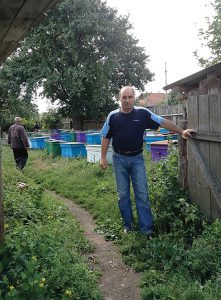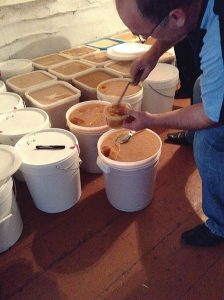By: Tom Rearick

Photo – Oleg Sadovskij in a “TORENT-TRADE” Ltd beeyard. Image used by permission. Copyright “TORENT-TRADE” Ltd.
One of the benefits of writing a bee blog is that I also get to meet interesting people from around the world. I recently started a dialog with Oleg Sadovskij, a Ukrainian beekeeper, a honey exporter, and manager of TORENT-TRADE Ltd. In Ukraine. I was curious about Ukraine because it is in the top five list of page visits by country to my blog (after US, Great Britain, France, & China).
Americans have heard a lot about Ukraine in the news this year yet few realize the long history and loyal compassion Ukrainians have for honey and the honey bee. There are about 400,000 beekeepers in Ukraine or 1 beekeeper for every 107 Ukrainians. In the U.S., that ratio is 1 in 1500! Ukraine is the largest producer of honey among European countries and Russia. On average, a Ukrainian consumes 2.6 lbs of honey annually – double what is consumed in the United States. In 1815 the Ukrainian Peter Prokopovich invented the movable-frame beehive though the American Langstroth discovered bee space which made his 1852 patent for movable frames much more practical. If you are a beekeeper or if you just like honey, then you will find Ukraine a very bee friendly place.
Here are some excerpts from our exchange.
Tom: In addition to being an exporter, you said that you are also a beekeeper. How many hives do you keep? Does your family help? Do you use other products of the hive like wax, propolis, or pollen?
Oleg: I have a couple of hives, but as a hobby, because I have little free time. I do not even have time to take them to the apiary in the field. There are acacia trees, a meadow and even gardens not far from my house. By the way, there are 90 houses in my street and the owners of four houses have small apiaries (from 10 to 25 hives). However, do not think that it is so everywhere. It is rather a coincidence.
My main occupation is the cooperation with beekeepers and honey export. I work as a manager. I am worried about the problem of this sector on the whole. So, I will answer the questions more professionally as a manager, not as an experienced beekeeper.
Tom: Do you use other products of the hive like wax, propolis, or pollen?
Oleg: Yes, propolis helps perfectly in case of toothache and I also make tinctures with propolis for applications. In Winter time I sometimes take one tablespoon of pollen on an empty stomach in the morning.
Tom: How does the cost of white sugar and corn syrup compare to honey?
Oleg: Corn syrup is not popular in our country, it is almost not used. Retail price for beet sugar is 12 UAH/kg [US$2.05/lb]. Retail price for honey (motley grass honey) is from 50 UAH/kg [US$8.53/lb].
Tom: My guess is that Ukrainians are much more knowledgeable and familiar with bees and beekeeping. Is that true?
Oleg: Beekeeping is much developed in Ukraine, in spite of the fact that there are no large companies in Ukraine that breed bees and harvest honey. However, there are many small apiaries and they cover the whole territory of Ukraine. There are about 400,000 beekeepers in Ukraine, with the total population of about 43 million. All these people do their best to get about 76,000 tons of honey per year. There is a great variety of honey produced by bees. Each honey has its own properties, taste and benefits.

Testing bulk honey. Image used by permission. Copyright “TORENT-TRADE” Ltd.
Tom: We have a huge problem in the U.S. with introduced bee diseases: Varroa mite, various viruses and micro-organisms, wax moth & hive beetle. Our winter losses have been averaging around 30% for the last several years. What pests or predators are of greatest concern in Ukraine? What are typical winter losses there?
Oleg: Yes, unfortunately, this problem is also typical for Ukraine, our Winter losses are up to 10%. For example, one beekeeper lost three of 100 bee families this Winter. The most frequently met pests are wax moths, ants, death’s head hawkmoths (they got this name because of a “skull” pattern on the top of their thorax), and rodents (mice).
Tom: Italian bees are probably the most popular race of bee in the U.S. I have been importing Russians because they are said to be more tolerant to Varroa. What can you tell me about the race of bees in Ukraine?
Oleg: Carpathian bees and Ukrainian steppe bees are the most popular races in Ukraine. I have Carpathian bees (they are called “peaceful” bees).
Tom: In the U.S., nearly all our honey is in liquid form. The honey in the picture looks like partially crystallized honey. I’ve heard that most honey in eastern Europe is thick and creamy like that. Is that correct?
Oleg: Yes, that is correct. Our honey is mainly in crystallized or paste like, but acacia honey and linden honey are liquid.
Tom: Ukraine is where the 1986 Chernobyl nuclear accident occurred. How do beekeepers or exporters ensure that honey is not radioactive?
Oleg: Radiological control is obligatory during the quality assessment of the Ukrainian honey. The indices of this analysis meet requirements of EU countries and the United States. Certainly, the beekeepers do not move their bees to the “dangerous” zone.
Tom: Finally, Oleg, is there anything you would like to say to beekeepers in the United States?
Oleg: I wish you success in work, favorable weather for good honey collection, success in the fight with bee pests and close communication with beekeepers from other countries for sharing the experience.
Oleg’s company, TORENT-TRADE Ltd., has an informative website at www.honey-export.com.
Tom Rearick is a UGA-certified Master Beekeeper and a member of the Metro Atlanta Beekeepers Association. His BeeHacker blog (beehacker.com), is a cross-pollination of technology and beekeeping.






